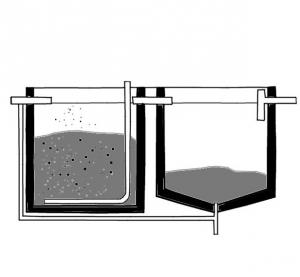Resumen ejecutivo
An activated sludge process refers to a multi-chamber reactor unit that makes use of highly concentrated microorganisms to degrade organics and remove nutrients from wastewater to produce a high-quality effluent. To maintain aerobic conditions and to keep the activated sludge suspended, a continuous and well-timed supply of oxygen is required. It consists of flocs of bacteria, which are suspended and mixed with wastewater in an aerated tank. The bacteria use the organic pollutants to grow and transform it to energy, water, CO2 and new cell material. Activated sludge systems are suspended-growth type and are used in conventional high-tech wastewater treatment plants to treat almost every wastewater influent as long as it is biodegradable. A physical pre-treatment unit, a post-settling unit (a clarifier) from which active sludge is re-circulated to the aerated tank, and excess sludge treatment, are compulsory for appropriate treatment. The process is highly mechanised and thus mainly adapted for centralised systems where energy, mechanical spare parts and skilled labour are available. Provided the reactor is well operated, a very good removal of organics and suspended solids can be achieved, though pathogen removal is low.
| Entradas | Salidas |
|---|---|
Blackwater, Brownwater, Greywater, Non-biodegradable Wastewater, Energy |
Treated Water, Fertigation Water |
Introduction
The term activated sludge refers to suspended aerobic sludge consisting of flocs of active bacteria, which consume and remove aerobically biodegradable organic substances from screened or screened and pre-settled wastewater. Activated sludge systems can treat blackwater, brownwater, greywater, faecal sludge and industrial wastewater as long as the pollutants to be treated are biodegradable.

Activated sludge reactors are aerobic suspended-growth type processes (in opposition to fixed-film or attached-growth processes (e.g. RBCs). Different configurations of the activated sludge process can be employed to ensure that the wastewater is mixed and aerated in an aeration tank. Aeration and mixing can be provided by pumping air or oxygen into the tank or by using surface aerators. The microorganisms oxidize the organic carbon in the wastewater to produce new cells, carbon dioxide and water. Although aerobic bacteria are the most common organisms, facultative bacteria along with higher organisms can be present. The exact composition of bacteria depends on the reactor design, environment, and wastewater characteristics.
The flocs (agglomerations of sludge particles), which form in the aerated tank, can be removed in the secondary clarifier by gravity settling. Some of this sludge is recycled from the clarifier back to the reactor. The effluent can be discharged into a river or treated in a tertiary treatment facility if necessary for further use.
In the view of reuse of the effluent in agriculture, it is not beneficial to remove all nutrients while standards for pathogen removal are barely met.
As the system is also of high complexity and strongly mechanised, it is mainly adapted for centralised systems where energy, mechanical and technical spare equipment and skilled staff are available.
Design Considerations
Activated sludge processes are one part of a complex wastewater treatment system (U.S. EPA 2002) . They are usually used following primary treatment ( including screening that removes settleable solids) , include one or more main aerated treatment chambers, aeration devices, a device for appropriate mixing to keep the sludge in suspension, a secondary clarifier to separate the biomass from the treated effluent and collect settled biomass, generally a non-linear, highly complex circulation regime (e.g. recirculation loops, by-passing etc.) and are sometimes followed by a final polishing step (see tertiary filtration and disinfection). The biological processes that occur are effective at removing soluble, colloidal and particulate materials. The reactor can be designed for biological nitrification and denitrification, as well as for biological phosphorus removal.
The design must be based on an accurate estimation of the wastewater composition and volume. Treatment efficiency can be severely compromised if the plant is under- or over-dimensioned. Depending on the temperature, the solids retention time (SRT) in the reactor ranges from 3 to 5 days for BOD removal, to 3 to 18 days for nitrification.
The excess sludge requires treatment to reduce its water and organic content and to obtain a stabilized product suitable for end-use or final disposal. It is important to consider this step in the planning phase of the treatment plant).
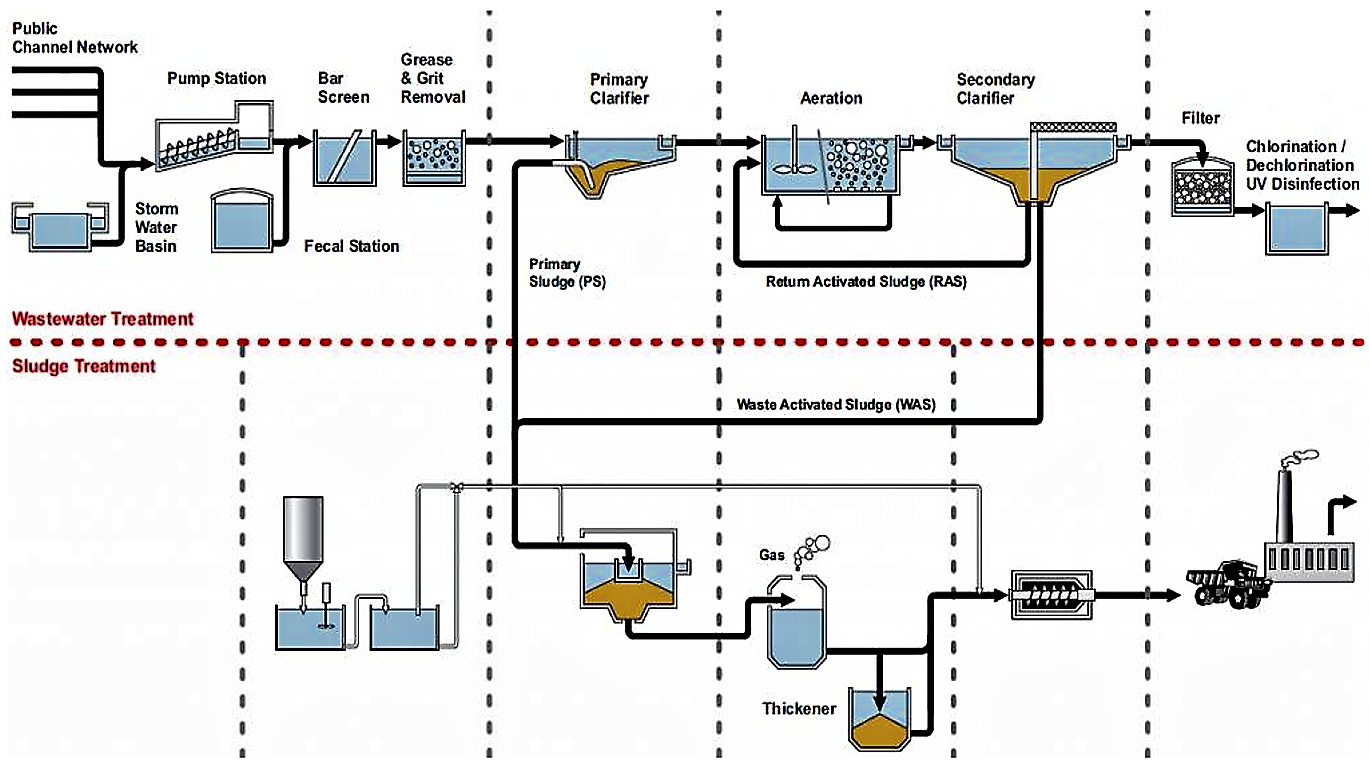
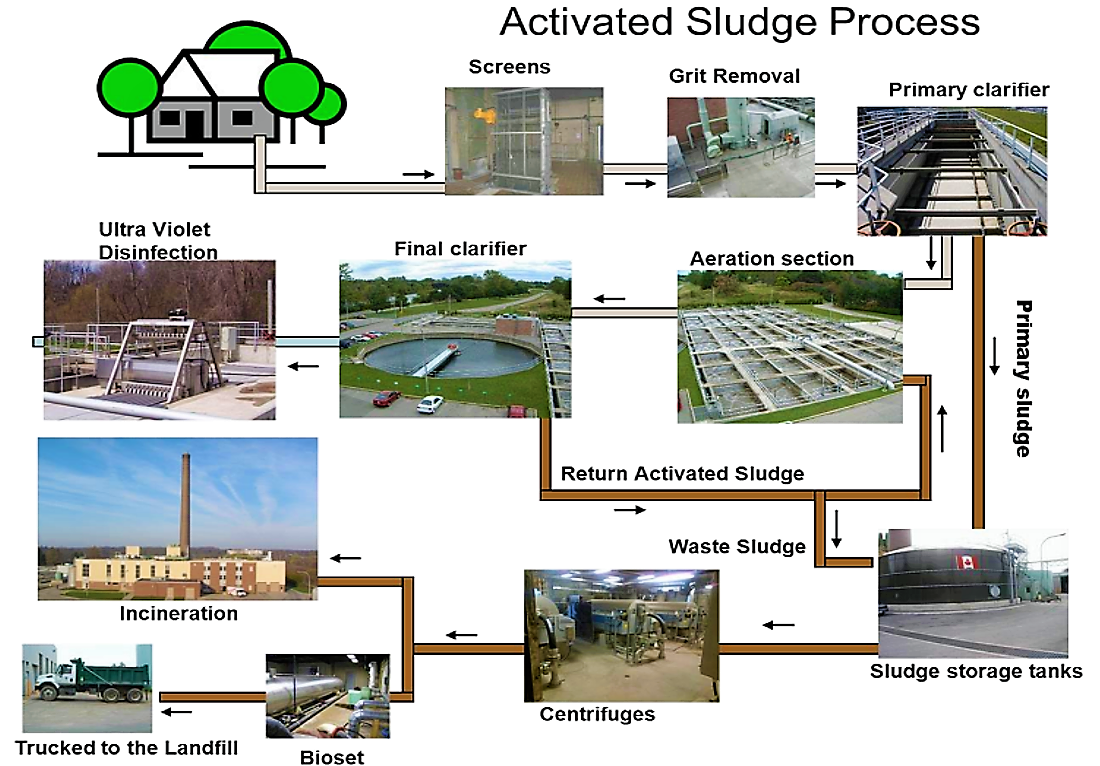
Large amounts of injected oxygen allow maintaining aerobic conditions and optimally mixing the active biomass with the wastewater to be treated. To maintain a relatively high amount of active microorganisms useful in removing organic substances from the wastewater, the sludge is separated from the effluent by settling in a secondary clarifier (UNEP 2004) or by membrane filtration and kept in the process by recirculation to the aeration tank. Several modifications of this basic process have been developed, including different aeration devices, different means of sludge collection and recycling to the aeration tank or primary clarifier, and process enhancement trough the addition of an inert media area on which biofilm can grow (combined fixed-film/suspended-growth process).
Although aerobic bacteria are the most dominant microorganisms in the process, other aerobic, anaerobic and/or nitrifying bacteria along with higher organisms can be present. Thus, besides the removal of organic matter, nutrients (organic ammonia, phosphorus) can also be removed biologically by nitrification/denitrification and biological uptake of phosphorus. The exact composition of microorganisms depends on the reactor design, the environment and the wastewater characteristics (TILLEY et al. 2008). To achieve optimal conditions for both, organic and nutrients removal, a sequences of changing aerobic and anaerobic chambers are used.
Detailed Treatment Process
After screening sand and similar heavy particles are removed next in a grit chamber where they settle to the ground. This chamber only wants to remove coarse grit and the wastewater spends only a relatively short period (some minutes) in it (UNEP & MURDOCH 2004). Smaller solids are removed in a settling or sedimentation tank. In this unit, the wastewater spends more time (about one hour) to allow for a good separation. The sludge from this mechanical primary treatment (including screening and settling in the grit chamber and the sedimentation tank) is called primary sludge and, as all excess sludge, requires an advanced further treatment chain.
After this primary treatment, the main unit containing the activated sludge follows. The pre-treated wastewater is mixed with the concentrated underflow activated sludge from the secondary clarifier in an aerated tank. Aeration is provided either by mechanical surface agitators or by submerged diffusers of compressed air (WSP 2008). Aeration provides oxygen to the activated sludge and at the same time thoroughly mixes the sludge and the wastewater (UNEP & MURDOCH 2004). During aeration and mixing, the bacteria form small clusters or flocs (TILLEY et al. 2008). Under these conditions, the bacteria in the activated sludge degrade the organic substances in the wastewater. They use the organic substance for energy, growth and reproduction. The end products are carbon dioxide (CO2), water (H2O) and new cells.
After a few hours in the aeration chamber, the mixture then enters the secondary settling tank (clarifier), where the flocculated microorganisms settle and are removed from the effluent stream. The settled microorganisms (the activated sludge) are then recycled to the head end of the aeration tank to be mixed again with wastewater and continue to grow and form new sludge and to degrade organics. To maintain an optimal amount of sludge in the system, the rate of recirculation of settled sludge varies from 20 to 100%. Excess sludge produced each day (waste activated sludge) must be processed in a further treatment chain together with the sludge from the primary treatment facilities. A conventional excess sludge treatment chain consists in anaerobic digestion, thickening, incineration and the safe disposal, e.g. in a landfill. A more sustainable way would be to compost the sludge (either before or instead of digestion) in order to reuse the nutrients in agriculture.
Hydraulic retention times in the whole systems range from some hours up to several days for the liquid phase. Proceeding of excess sludge can take somehow longer depending on the type of thickening and anaerobic digestion applied. The effluent from a properly designed and operated activated-sludge plant is of high quality, usually having BOD and TSS concentrations equal to or less than 10 mg/L (CRITES & TCHOBANOGLOUS 1998). The removal of both, biological oxygen demand (BOD) and suspended solids (TSS) generally lies within 80 to 100% depending on the influent concentrations, the system set-up and temperature (UNEP 2004; SANIMAS 2005; WSP 2008).
Nutrients such as nitrogen and phosphorus are also removed in activated sludge process but require a set-up of different aerated and non-aerated chambers in hybrid activated sludge systems. Biological removal of nitrogen is first achieved by the transformation of organic nitrogen into ammonia, followed by the aerobic conversion of ammonia (NH4+) to nitrite (NO2-) and then nitrate (NO3-) and the anaerobic transformation of nitrate to gaseous nitrogen (N2), which is then released to the atmosphere. The transformation of ammonia to nitrate via an intermediate step of nitrite is called nitrification. The transformation of nitrate to gaseous nitrogen is referred as denitrification. Thus, a combination of both, aerobic and anaerobic (anoxic) processes are required to achieve complete elimination of nitrogen from the wastewater. In many activated sludge treatment systems, An anaerobic tank is either integrated after the aerated basin and before clarification (post-denitrification); or just before the aeration tank (pre-denitrification). In the case of pre-denitrification, nitrification takes place in the aerated tank after the aerobic pre-tank. Denitrification only occurs when the effluent from the aerated tank, containing nitrite, is re-circulated like the sludge.
The removal of phosphorus in activated sludge systems can be done chemically or biologically. Biological elimination of phosphorus in conventional wastewater treatment system occurs through the uptake of phosphorus by some bacterial cells. However, only little phosphorus can be removed this way, as the phosphorus mass fraction in volatile sludge is only about 2.5% (HAANDEL&LUBBE 2007). This results in an effluent concentration of about 2 to 7 mg P/L for municipal sewage with a COD concentration of 500 mg/L (HAANDEL&LUBBE 2007). However, it will in general be required to lower the effluent phosphorus concentration to a value ≤ 1 mg P/L.
Another biological process is the enhanced biological phosphorus removal. Enhanced biological phosphorus removal is based on the cultivation of some special phosphorus accumulating bacteria, which, compared to 2.5% P in conventional activated sludge, can lead to up to 38% of P accumulation in the sludge (HAANDEL&LUBBE 2007).
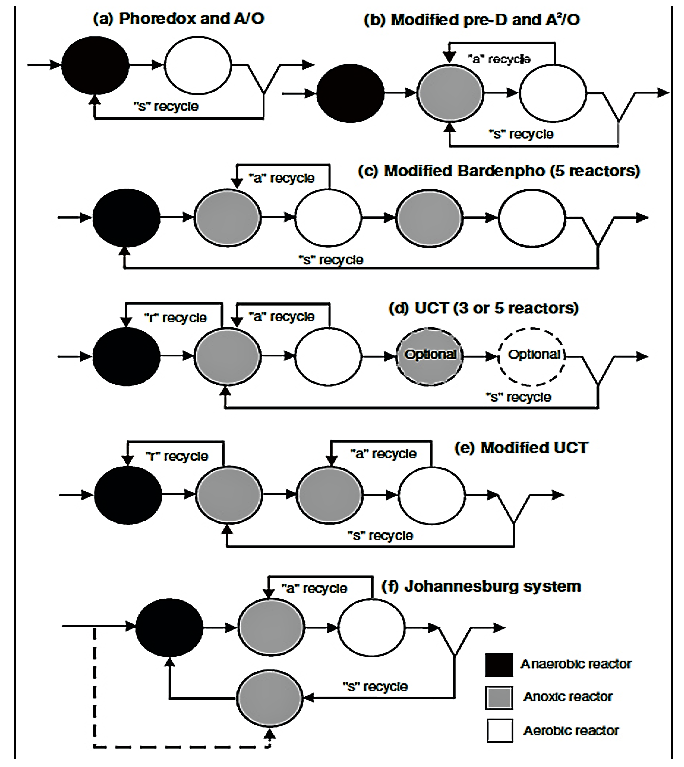
When both nitrogen and phosphorus are to be removed, the combination becomes even more complex. Enhanced biological phosphorus removal requires generally an anaerobic stage (for PAO cultivation), an anoxic stage (for denitrification) and an aerobic stage (for nitrification and phosphorus accumulation) in series.
Nowadays, activated sludge systems, where valuable nutrients (phosphorus and nitrogen) and organic matter are incinerated instead of re-circulated to the food production in agriculture are not perceived as sustainable any more. The introduction of nitrogen removal into an activated sludge plant increases the reactor volume significantly and leads to higher energy consumption of approximately 60 to 80% for aeration (MAURER 2003). The elimination of phosphorus requires either the addition of chemicals and subsequent disposal of inorganic sludge or an increase of complexity and reactor volume for enhanced biological phosphorus removal.
To achieve specific effluent goals for BOD, nitrogen and phosphorus, different adaptations and modifications have been made to the basic activated sludge design. Well known modifications include sequencing batch reactors (SBR), oxidation ditches, deep shafts, extended aeration, moving beds and membrane bioreactors.
Sequential Batch Reactors (SBRs)

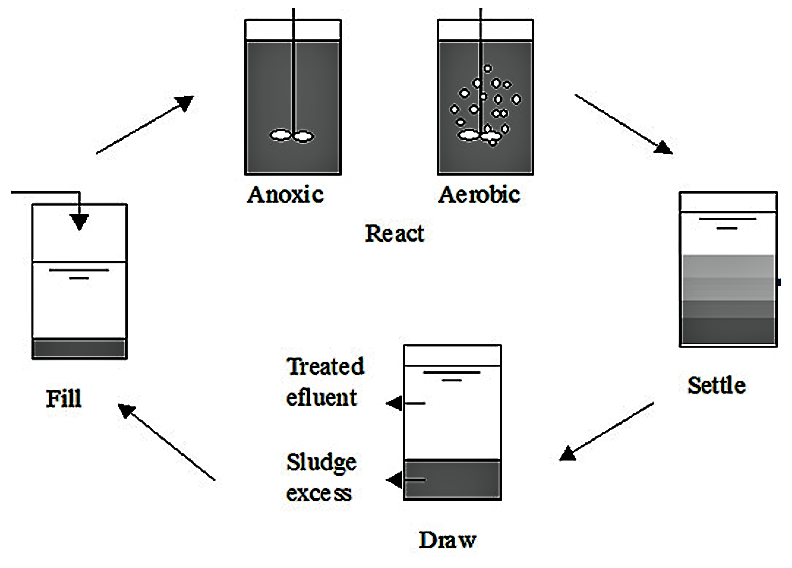
The process can be operated in batches, where the different conditions are all achieved in the same reactor but at different times (UNEP & MURDOCH 2004). The treatment consists of a cycle of five stages: fill, react, settle, draw and idle. During the reaction type, oxygen is added by an aeration system. During this phase, bacteria oxidize the organic matter just as in activated sludge systems. Thereafter, aeration is stopped to allow the sludge to settle. In the next step, the water and the sludge are separated by decantation and the clear layer (supernatant) is discharged from the reaction chamber (METCALF & EDDY 2007). Depending on the rate of sludge production, some sludge may also be purged. After a phase of idle the tank is filled with a new batch of wastewater (UNEP & MURDOCH 2004). At least two tanks are needed for the batch mode of operation as continuous influent needs to be stored during the operation phase. (Very) small systems (e.g. serving small settlements) may apply only one tank. In this case, the influent must either be retained in a pond or continuously discharged to the bottom of the tank in order to not disturb the settling, draw and idle phases. SBRs are suited to lower flows because the size of each tank is determined by the volume of wastewater produced during the treatment period in the other tank (UNEP & MURDOCH 2004). For more information on SBR activated sludge systems, please consult WSP (2007) or U.S. EPA (1999).
Oxidation Ditches
Oxidation ditches are large round or oval ditches (channel reactors) with one or more horizontal aerators to guarantee oxygen supply, and to mix and move the content around the ditch. Screened influent enters the oxidation ditch, is aerated and circulates at about 0.25 to 0.35 m/s (SANIMAS 2005). Operation can be continuous or intermittent. Primary sedimentation is usually not required, but secondary sedimentation tanks are generally used. The required treatment volume per capita is about 1 m³ (SANIMAS 2005). Oxidation ditches are suitable for areas where land availability is high. They have the advantage that they are relatively easy to maintain and are resilient to shock loads that often occur in smaller communities (e.g. at breakfast time and in the evening). Typical hydraulic retention time is between 24 to 48 hours with a sludge age of 12 to 20 days (Wikipedia 2010). For more information on oxidation ditches, please refer to U.S. EPA (2000), WSP (2007) or WSP (2008).
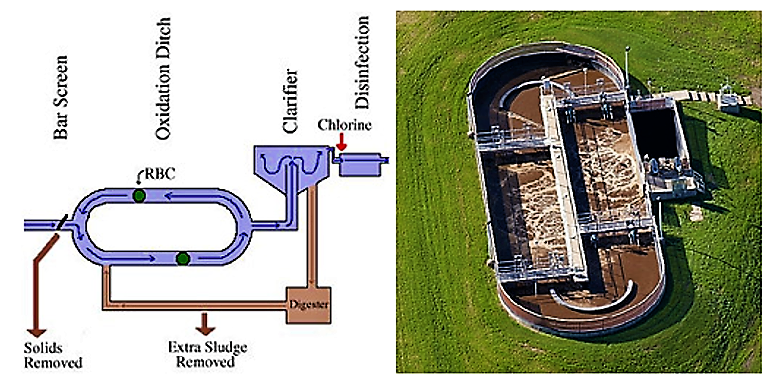
Deep Shafts
Where land is in short supply, sewage may be treated by injection of oxygen into a pressured return sludge stream, which is injected into the base of a deep columnar tank buried in the ground. This type of activated sludge reactor is called deep shaft. Such shafts may be up to 100 m deep. As the sewage rises the oxygen forced into solution by the pressure at the base of the shaft breaks out as molecular oxygen. This provides a highly efficient source of oxygen for the microorganisms contained in the activated sludge. The rising oxygen and injected return sludge provide the physical mechanism for mixing. Mixed sludge and wastewater influent is decanted at the surface and separated into supernatant and sludge components. The efficiency of deep shaft treatment can be high but they require skilled professionals for construction, operation and maintenance; and additionally a large amount of energy (adapted from Wikipedia (2012)).
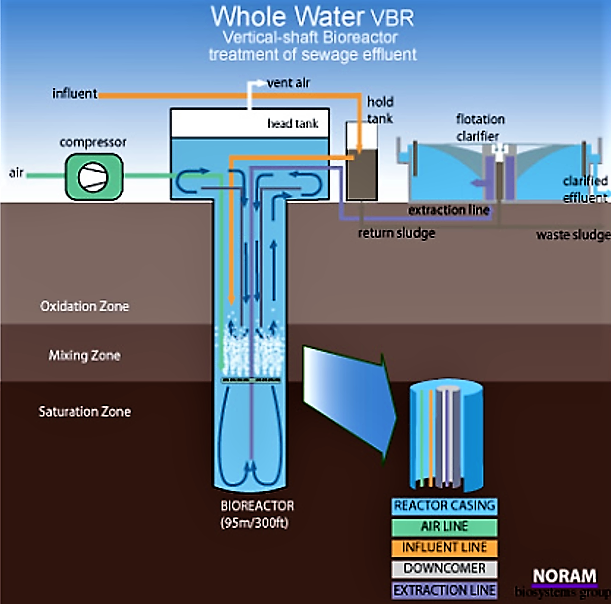
Health Aspects/Acceptance
Operation and maintenance of activated sludge system is generally carried out by skilled labourers, which should be sufficiently well trained regarding any health risks. Because of space requirements and odours, Centralized Treatment facilities are generally located in the periphery of densely populated areas. Although the effluent produced is of high quality, it still poses a health risk and should not be directly handled but undergo an appropriate disinfection treatment before discharge (e.g. UV-light, chlorination) . In the excess sludge pathogens are substantially reduced, but not eliminated.
Excess sludge contains even higher amounts of microorganisms, as well as phosphorus and heavy metals if they are present in the influent wastewater. This can be the case because the wastewater treated in such reactors generally comes from an array of different sources (domestic, industrial and stormwater), which makes it a hard-to-treat mixture and therefore also a difficult resource to recycle. Hence, the sludge generally needs to be thickened and incinerated with the ashes being stored in a controlled landfill.
Operation & Maintenance
Highly trained staff is required for maintenance and trouble-shooting. The mechanical equipment (mixers, aerators and pumps) must be constantly maintained. A continuous supply of oxygen and sludge is essential (WSP 2008). Control of concentrations of sludge and oxygen levels in the aeration tanks is required and technical appliances (e.g. pH-meter, temperature, oxygen content etc.) need to be maintained carefully. As well, the influent and effluent must be constantly monitored and the control parameters adjusted, if necessary, to avoid abnormalities that could kill the active biomass and the development of detrimental organisms which could impair the process (e.g., filamentous bacteria).
Two of the most serious problems with the activated-sludge process are (1) a phenomenon known as bulking, in which the sludge from the aeration tank will not settle, and (2) the development of biological surface foam (CRITES & TCHOBANOGLOUS 1998). Bulking can be caused either by organisms that grow in filamentous form instead of flocs and will not settle, or the growth of microorganisms that incorporate large volumes of water into their cell structure, making their density near that of water. Foaming is caused most often by the excessive growth of an organism called Nocardia (CRITES & TCHOBANOGLOUS 1998). Filamentous organisms can be controlled by the addition of chemicals (e.g. chlorine or hydrogen peroxide) to the recycled activated sludge; the alteration of the dissolved-oxygen concentration in the aeration tank; the addition of nutrients and growth factors to favour other microorganisms etc. Nocardia can be controlled by avoiding the recycling of the skimmed foam or the addition of a chemical agent (e.g. polymers or chlorine) on the surface (CRITES & TCHOBANOGLOUS 1998).
At a Glance
| Working Principle | Activated sludge consisting of suspended flocs of active bacteria is mixed with the wastewater. The organic pollutants are used for growth by bacteria and thereby transformed to water, CO2 and new cell material. Nitrogen is removed by nitrification/denitrification and phosphorus is either removed chemically or biologically and accumulated in the excess sludge. Excess sludge requires a further treatment chain. |
| Capacity/Adequacy | High-tech centralized system, not adapted for small communities. Almost every wastewater can be treated as long as it is biodegradable. Usually applied in densely populated areas for treatment of domestic wastewater. |
| Performance | 80 to almost 100% BOD and TSS removal. High nitrogen removal. P accumulated in biomass and sludge. Low pathogen removal. HRT of some hours up to several days |
| Costs | Very high construction and maintenance costs; operation very expensive due to requirement of permanent professional operation, high electricity consumption and costly mechanical parts. |
| Self-help Compatibility | System parts not locally available; implementation only possible by experienced consultant firms. |
| O&M | Activated sludge units require professional operation and maintenance providers. |
| Reliability | Fails in case of power failure or fall-out of technical equipment. |
| Main strength | High removal efficiency for large range of wastewaters. |
| Main weakness | Highly mechanized system requiring expert design, operation and maintenance as well as mechanical spare parts. Large energy requirements (e.g. for aeration). |
An activated sludge process is only appropriate for a Centralized Treatment facility (SASSE 1996; TILLEY et al. 2008) with the construction of long distance sewage channels, a well-trained staff, constant electricity , technical equipment (e.g. spare parts, monitoring appliances), the funding for all of this, and a highly developed management system that ensures that the facility is correctly operated and maintained.
Because of economies of scale and less fluctuating influent characteristics, this technology is more effective for the treatment of large volumes of flows of municipal wastewater from medium to large towns (WSP 2008) of 10000 up to 1 million population equivalent (SANIMAS 2005; TILLEY et al. 2008) .
An activated sludge process is appropriate in almost every climate for the removal of both settable (physical primary treatment) and dissolved, colloidal and particulate organic matter and nutrients (biological removal in the activated sludge) . However, treatment capacity is reduced in colder environments.
Managing the other side of the Water Cycle - Making Wastewater an Asset
Schematic view of an activated WWTP using the Sequencing Batch Reactor
Activated Sludge Process
Small and Decentralized Wastewater Management Systems
Decentralised wastewater management presents a comprehensive approach to the design of both conventional and innovative systems for the treatment and disposal of wastewater or the reuse of treaded effluent. Smaller treatment plants, which are the concern of most new engineers, are the primary focus of this book.
CRITES, R. TCHOBANOGLOUS, G. (1998): Small and Decentralized Wastewater Management Systems. New York: The McGraw-Hill Companies IncGuide to Instrumentation in Wastewater
Mechanisms involved in Biological Phosphorus removal
Possibilities and Limits of Wastewater-fed Aquaculture
At the University of Applied Sciences Waedenswil, Switzerland, wastewater-fed aquaculture is a research focus since 1993. This paper summarises some of the results and insights gained since then.
JUNGE-BERBEROVIC, R. University of Applied Sciences Waedenswil. (2001): Possibilities and Limits of Wastewater-fed Aquaculture. Waedenswil: University of Applied Sciences Waedenswil URL [Visita: 19.02.2010]Appropriate Technology for Municipal Sewerage/Excreta Management in Developing Countries, Thailand Case Study
Assessment of the appropriateness of activated sludge for Thailand.
LUDWIG, H. F. ; MOHIT, K. (2000): Appropriate Technology for Municipal Sewerage/Excreta Management in Developing Countries, Thailand Case Study. Entradas: The Environmentalist: Volume 20 , 215-219. URL [Visita: 19.08.2014]Nutrients in urine: energetic aspects of removal and recovery
The analysis of different removal and recovery techniques for nutrients in urine shows that in many cases recovery is energetically more efficient than removal and new production from natural resources.
MAURER, M. ; SCHWEGLER, T. ; SCHWEGLER, P. ; LARSEN, T.A. (2003): Nutrients in urine: energetic aspects of removal and recovery. Entradas: Water Science and Technology 8: Volume 1 , 37-46.Community-Based Technologies for Domestic Wastewater Treatment and Reuse- options for urban agriculture
The report suggests that emerging trends in low-cost, decentralised naturally-based infrastructure and urban wastewater management which promote the recovery and reuse of wastewater resources are increasingly relevant. Technologies for these sanitation options are presented. The concept of managing urban wastewater flows at a decentralised or "intermediate" level, based on micro watersheds, is explored. Effluent treatment standards that are currently accepted in order to protect public health and safety are reviewed.
ROSE, D.G. (1999): Community-Based Technologies for Domestic Wastewater Treatment and Reuse- options for urban agriculture. (= Cities Feeding People (CFP) Report Series. , 27 ). Ottawa: International Development Research Center Canada (IDRC) URL [Visita: 23.05.2018]Informed Choice Catalogue
This informed choice catalogue for community based wastewater treatment technologies helps to identify suitable sanitation options and facilitates the assessment of different sanitation system components with regard to stakeholder preferences. A powerful tool for technical bottom-up planning giving overall information about technical options at a "glance".
SANIMAS (2005): Informed Choice Catalogue. pdf presentation. BORDA and USAID URL [Visita: 29.05.2019]Biological Wastewater Treatment in Warm Climate Regions Volume 2
Biological Wastewater Treatment in Warm Climate Regions gives a state-of-the-art presentation of the science and technology of biological wastewater treatment, particularly domestic sewage. The book covers the main treatment processes used worldwide with wastewater treatment in warm climate regions given a particular emphasis where simple, affordable and sustainable solutions are required. The 55 chapters are divided into 7 parts over two volumes: Volume One (also available in the SSWM library): Introduction to wastewater characteristics, treatment and disposal; Basic principles of wastewater treatment; Stabilisation ponds; Anaerobic reactors; Volume Two: Activated sludge; Aerobic biofilm reactors; Sludge treatment and disposal.
SPERLING, M. von LEMOS CHERNICHARO, C.A. de (2005): Biological Wastewater Treatment in Warm Climate Regions Volume 2. London: International Water Association (IWA) Publishing URL [Visita: 26.05.2019]Wastewater Engineering, Treatment and Reuse
Compendium of Sanitation Systems and Technologies. 2nd Revised Edition
This compendium gives a systematic overview on different sanitation systems and technologies and describes a wide range of available low-cost sanitation technologies.
TILLEY, E., ULRICH L., LÜTHI, C., REYMOND P. and ZURBRÜGG C. (2014): Compendium of Sanitation Systems and Technologies. 2nd Revised Edition. Duebendorf, Switzerland: Swiss Federal Institute of Aquatic Science and Technology (Eawag) URL [Visita: 03.05.2023] PDFCompendium of Sanitation Systems and Technologies
This compendium gives a systematic overview on different sanitation systems and technologies and describes a wide range of available low-cost sanitation technologies.
TILLEY, E., LUETHI, C., MOREL, A., ZURBRUEGG, C. and SCHERTENLEIB, R. (2008): Compendium of Sanitation Systems and Technologies. Duebendorf, Switzerland: Swiss Federal Institute of Aquatic Science and Technology (EAWAG) and Water Supply and Sanitation Collaborative Council (WSSCC) URL [Visita: 15.02.2010] PDFSequencing Batch Reactors
Technical factsheet on the design, application, performance and operation of sequencing batch reactors (SBRs), a type of activated sludge wastewater treatment plants. English, Spanish
U.S. EPA (1999): Sequencing Batch Reactors. (= Wastewater Technology Fact Sheet, EPA 832-F-99-073 ). United States Environment Protection Agency (U.S. EPA)Oxidation Ditches
Onsite Wastewater Treatment Systems Manual
Rather old design manual for onsite wastewater treatment options. However, valuable information on established systems such as septic tanks, sand filters, aerobic treatment units (suspended growth and fixed film), disinfection, nutrient removal as well as wastewater segregation and recycling are given. Additional information is given on disposal methods and appurtenances.
U.S.EPA (1980): Onsite Wastewater Treatment Systems Manual. (= EPA 625/1-80 , 12 ). United States Environmental Protection Agency, Office of Water Office of Research and DevelopmentA Directory of Environmentally Sound Technologies for the Integrated Management of Solid, Liquid and Hazardous Waste for SIDS in the Caribbean Region
This directory is part of UNEP collaboration with SIDS on the implementation of the Waste Management chapter of the Barbados Programme of Action. It focuses primarily on proven sound environmental technologies for solid, liquid and hazardous waste management plus those currently successfully being used in SIDS within the Caribbean Region.
UNEP (2004): A Directory of Environmentally Sound Technologies for the Integrated Management of Solid, Liquid and Hazardous Waste for SIDS in the Caribbean Region. Nairobi: United Nations Environment Programme Global Programme of Action (UNEP-GPA)) and Caribbean Environmental Health Institute (CEHI) URL [Visita: 04.08.2023] PDFEnvironmentally sound technologies in wastewater treatment for the implementation of the UNEP/GPA "Guidelines on Municipal Wastewater Management"
Technical information on environmentally sound technologies in wastewater treatment.
UNEP ; MURDOCH UNIVERSITY (2004): Environmentally sound technologies in wastewater treatment for the implementation of the UNEP/GPA "Guidelines on Municipal Wastewater Management". The Hague: United Nations Environment Programme Global Programme of Action (UNEP/GPA), Coordination OfficeSewage treatment in a deep shaft activated sludge system
Ecological Sanitation - revised and enlarged edition
This book is one of the most fundamental and important books that defined the concept of ecological sanitation. The first version came out in 1998 - this version presents the findings of over ten years of research and development in ecological sanitation supported by SIDA (Swedish International Development Cooperation Agency).
WINBLAD, U. SIMPSON-HERBERT, M. (2004): Ecological Sanitation - revised and enlarged edition. (pdf presentation). Sweden: Stockholm Environment Institute URL [Visita: 04.08.2010]Belebtschlammverfahren
Language: Spanish
Ecological Sanitation - revised and enlarged edition
This book is one of the most fundamental and important books that defined the concept of ecological sanitation. The first version came out in 1998 - this version presents the findings of over ten years of research and development in ecological sanitation supported by SIDA (Swedish International Development Cooperation Agency).
WINBLAD, U. SIMPSON-HERBERT, M. (2004): Ecological Sanitation - revised and enlarged edition. (pdf presentation). Sweden: Stockholm Environment Institute URL [Visita: 04.08.2010]Philippines Sanitation Source Book and Decision Aid
This Sanitation Sourcebook distils some of the core concepts of sanitation in a user-friendly format so that the book can serve as a practical reference to sanitation professionals and investment decision-makers, particularly the local governments. The annexe contains a practical collection of factsheets on selected sanitation system options.
WSP (2007): Philippines Sanitation Source Book and Decision Aid. pdf presentation. Washington: Water and Sanitation Program (WSP). URL [Visita: 01.06.2019]Technology Options for Urban Sanitation in India. A Guide to Decision-Making
These guidance notes are designed to provide state governments and urban local bodies with additional information on available technologies on sanitation. The notes also aid in making an informed choice and explain the suitability of approaches.
WSP (2008): Technology Options for Urban Sanitation in India. A Guide to Decision-Making. pdf presentation. New Delhi: Water and Sanitation Program (WSP) URL [Visita: 03.06.2019]Compendium of Sanitation Systems and Technologies (Arabic)
This is the Arabic version of the Compendium of Sanitation Systems and Technologies. The Compendium gives a systematic overview on different sanitation systems and technologies and describes a wide range of available low-cost sanitation technologies.
TILLEY, E. ULRICH, L. LUETHI, C. REYMOND, P. SCHERTENLEIB, R. ZURBRUEGG, C. (2014): Compendium of Sanitation Systems and Technologies (Arabic). 2nd Revised Edition. Duebendorf, Switzerland: Swiss Federal Institute of Aquatic Science and Technology (Eawag) PDFSmall and Decentralized Wastewater Management Systems
Decentralised wastewater management presents a comprehensive approach to the design of both conventional and innovative systems for the treatment and disposal of wastewater or the reuse of treaded effluent. Smaller treatment plants, which are the concern of most new engineers, are the primary focus of this book.
CRITES, R. TCHOBANOGLOUS, G. (1998): Small and Decentralized Wastewater Management Systems. New York: The McGraw-Hill Companies IncSOS - Management of Sludges from On-Site Sanitation. Co-treatment of Faecal Sludge and Wastewater in Tropical Climates
This article provides operational and design guidance for the co-treatment of faecal sludge in waste stabilisation ponds and in activated sludge sewage treatment plants. Problems which may arise when highly concentrated faecal sludge is not properly included in the design of the co-treatment system are also discussed.
HEINSS, U. STRAUSS, M. (1999): SOS - Management of Sludges from On-Site Sanitation. Co-treatment of Faecal Sludge and Wastewater in Tropical Climates. Duebendorf and Accra: Swiss Federal Institute of Aquatic Science (EAWAG) URL [Visita: 21.04.2010]Sustainable Wastewater Treatment
Wastewater contains organic matter and the three main nutrients for plant production: nitrogen, phosphorus and potassium. Nitrogen fertilizer is energy consuming to produce and phosphorus is a limited mineral resource. Scandinavia is pioneering sustainable solutions to wastewater treatment. Source separation (blackwater/greywater) systems produce almost zero emissions and open up exiting urban applications of sanitation options in order to close the loop.
JENSSEN, P.D. VRAALE, L. LINDHOLM, O. SENG, L. (2007): Sustainable Wastewater Treatment. Entradas: SENG, L. (2007): Proceedings of the International Conference on Natural Resources and Environmental Management and Environmental Safety and Health. Norway: .Nutrients in urine: energetic aspects of removal and recovery
The analysis of different removal and recovery techniques for nutrients in urine shows that in many cases recovery is energetically more efficient than removal and new production from natural resources.
MAURER, M. ; SCHWEGLER, T. ; SCHWEGLER, P. ; LARSEN, T.A. (2003): Nutrients in urine: energetic aspects of removal and recovery. Entradas: Water Science and Technology 8: Volume 1 , 37-46.Water Pollution Control - A Guide to the Use of Water Quality Management Principles
This document is rather old, but its publication was a milestone as it demonstrates WSSCCs capacity to bring together water and sanitation professionals from industrialised and developing countries to formulate practical guidance on a key issue of the day. Mainly regulatory, financial and technical aspects are discussed and illustrated with an extensive collection of case studies from the developing world.
HELMER, R. ; HESPANHOL, I. (1997): Water Pollution Control - A Guide to the Use of Water Quality Management Principles. World Health Organization (WHO), Water Supply and Sanitation Collaborative Council (WSSCC) and United Nations Environment Programme (UNEP) URL [Visita: 21.04.2010]Philippines Sanitation Source Book and Decision Aid
This Sanitation Sourcebook distils some of the core concepts of sanitation in a user-friendly format so that the book can serve as a practical reference to sanitation professionals and investment decision-makers, particularly the local governments. The annexe contains a practical collection of factsheets on selected sanitation system options.
WSP (2007): Philippines Sanitation Source Book and Decision Aid. pdf presentation. Washington: Water and Sanitation Program (WSP). URL [Visita: 01.06.2019]Technology Options for Urban Sanitation in India. A Guide to Decision-Making
These guidance notes are designed to provide state governments and urban local bodies with additional information on available technologies on sanitation. The notes also aid in making an informed choice and explain the suitability of approaches.
WSP (2008): Technology Options for Urban Sanitation in India. A Guide to Decision-Making. pdf presentation. New Delhi: Water and Sanitation Program (WSP) URL [Visita: 03.06.2019]Basic Principles of Wastewater Treatment
Basic Principles of Wastewater Treatment is the second volume in the series Biological Wastewater Treatment, and focusses on the unit operations and processes associated with biological wastewater treatment. The major topics covered are: microbiology and ecology of wastewater treatment, reaction kinetics and reactor hydraulics, conversion of organic and inorganic matter, sedimentation, aeration.
SPERLING, M. von (2007): Basic Principles of Wastewater Treatment. (= Biological Wastewater Treatment Series , 2 ). London: International Water Association (IWA) Publishing URL [Visita: 26.05.2019]Activated Sludge and Aerobic Biofilm Reactors
Activated Sludge and Aerobic Biofilm Reactors is the fifth volume in the series Biological Wastewater Treatment. The first part of the book is devoted to the activated sludge process, covering the removal of organic matter, nitrogen and phosphorus. A detailed analysis of the biological reactor (aeration tank) and the final sedimentation tanks is provided. The second part of the book covers aerobic biofilm reactors, especially trickling filters, rotating biological contractors and submerged aerated biofilters. For all the systems, the book presents in a clear and informative way the main concepts, working principles, expected removal efficiencies, design criteria, design examples, construction aspects and operational guidelines.
SPERLING, M. von (2007): Activated Sludge and Aerobic Biofilm Reactors. (= Biological Wastewater Treatment Series , 5 ). London: International Water Association (IWA) Publishing URL [Visita: 03.06.2019]Biological Wastewater Treatment in Warm Climate Regions Volume 2
Biological Wastewater Treatment in Warm Climate Regions gives a state-of-the-art presentation of the science and technology of biological wastewater treatment, particularly domestic sewage. The book covers the main treatment processes used worldwide with wastewater treatment in warm climate regions given a particular emphasis where simple, affordable and sustainable solutions are required. The 55 chapters are divided into 7 parts over two volumes: Volume One (also available in the SSWM library): Introduction to wastewater characteristics, treatment and disposal; Basic principles of wastewater treatment; Stabilisation ponds; Anaerobic reactors; Volume Two: Activated sludge; Aerobic biofilm reactors; Sludge treatment and disposal.
SPERLING, M. von LEMOS CHERNICHARO, C.A. de (2005): Biological Wastewater Treatment in Warm Climate Regions Volume 2. London: International Water Association (IWA) Publishing URL [Visita: 26.05.2019]Wastewater Engineering, Treatment and Reuse
Box 4.2: Forest irrigation in Kaageroed
Case study from Sweden, describing forest irrigation as a final treatment step and reuse option for activated sludge effluents.
BODIK, I. RIDDERSTOLPE, P. (2008): Box 4.2: Forest irrigation in Kaageroed. Entradas: BODIK, I. ; RIDDERSTOLPE, P. (2008): Sustainable sanitation in Central and Eastern Europe - addressing the needs of small and medium-size settlements. Stockholm: 68 . URL [Visita: 21.04.2010]Opportunities in Fecal Sludge Management for Cities in Developing Countries: Experiences from the Philippines
In July 2012, a team from RTI International deployed to the Philippines to evaluate four FSM programs with the goal of reporting on best practices and lessons learned. The four cases—Dumaguete City, San Fernando City, Maynilad Water for the west zone of metro Manila, and Manila Water from the east zone of metro Manila—were chosen to highlight their different approaches to implementing FSM.
ROBBINS, D. STRANDE, L. DOCZI, J. (2012): Opportunities in Fecal Sludge Management for Cities in Developing Countries: Experiences from the Philippines. North Carolina: RTI International URL [Visita: 10.06.2019]Anaerobic Digestion of Blackwater and Kitchen Refuse
Thesis assessing the anaerobic treatment of blackwater (toilet wastewater) from vacuum toilets without and with kitchen refuse and its potential for reuse and resources management sanitation concepts.
WENDLAND, C. (2008): Anaerobic Digestion of Blackwater and Kitchen Refuse. (PhD Thesis). (= Hamburger Berichte zur Siedlungswasserwirtschaft ). Hamburg: Institut fuer Abwasserwirtschaft und Gewaesserschutz (AWW), Technische Universitaet Hamburg-Hamburg (TUHH) URL [Visita: 11.03.2010]Design Manual - Onsite Wastewater Treatment and Disposal Systems
Rather old design manual for onsite wastewater treatment options. However, valuable information on established systems such as septic tanks, sandfilters, aerobic treatment units (suspendend growth and fixed film), disinfection, nutrient removal as well as wastewater segregation and recycling are given. Additional information is given on disposal methods and appurtenances.
U.S. EPA (1980): Design Manual - Onsite Wastewater Treatment and Disposal Systems. (= EPA 625/1-80-0 ). United States Environmental Protection Agency and Office of Water Office of Research and Development URL [Visita: 27.05.2019]4.2.1 Activated sludge treatment
Oxidation Ditches
Sequencing Batch Reactors
Technical factsheet on the design, application, performance and operation of sequencing batch reactors (SBRs), a type of activated sludge wastewater treatment plants. English, Spanish
U.S. EPA (1999): Sequencing Batch Reactors. (= Wastewater Technology Fact Sheet, EPA 832-F-99-073 ). United States Environment Protection Agency (U.S. EPA)Course ENV149: Wastewater Treatment Plant Operation: Lesson 10: Secondary Treatment
The Mountain Empire Community College ‘Water and Wastewater Distance Learning Course’ makes available all its documentation on the web. This section describes secondary treatment systems, including trickling filters, rotating biological contactors, activated sludge, operation and control, stabilization ponds, aerated lagoons and intermittent sand filters.
MECC (n.y): Course ENV149: Wastewater Treatment Plant Operation: Lesson 10: Secondary Treatment. (= Mountain Empire Community College. Water and Wastewater Distance Learning ). Big Stone Gap: Mountain Empire Community College (MECC) URL [Visita: 18.03.2010]Sustainable Wastewater Treatment
Wastewater contains organic matter and the three main nutrients for plant production: nitrogen, phosphorus and potassium. Nitrogen fertilizer is energy consuming to produce and phosphorus is a limited mineral resource. Scandinavia is pioneering sustainable solutions to wastewater treatment. Source separation (blackwater/greywater) systems produce almost zero emissions and open up exiting urban applications of sanitation options in order to close the loop.
JENSSEN, P.D. VRAALE, L. LINDHOLM, O. SENG, L. (2007): Sustainable Wastewater Treatment. Entradas: SENG, L. (2007): Proceedings of the International Conference on Natural Resources and Environmental Management and Environmental Safety and Health. Norway: .ecosan - A Possible Approach to Sustainable Sanitation And Food Security
This master thesis illustrates the history of conventional wastewater treatment and the shift in paradigm towards recycling-oriented systems.
NEUPANE, K. (2004): ecosan - A Possible Approach to Sustainable Sanitation And Food Security. (= Master Thesis ). University of Applied Science Nordostniedersachenhttp://en.wikipedia.org
General Wikipedia article on activated sludge systems.
http://web.deu.edu.tr/atiksu/ana52/ani406.html
Different material on activated sludge wastewater treatment systems available on the Tropak Hompage hosted by the Turkish Dokuz Eylul University in Izmir.
http://www.ademe.fr/partenaires/Boues/Pages/f14.htm
This page explains in a very short and comprehensive way how activated sludge processes are applied for municipal wastewater treatment in France.

